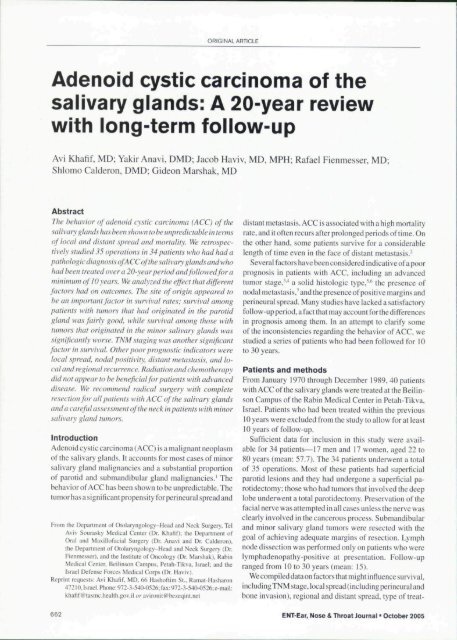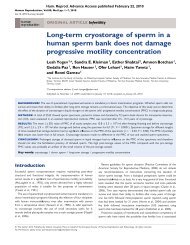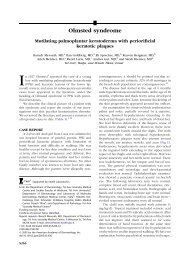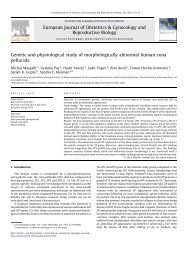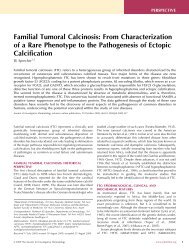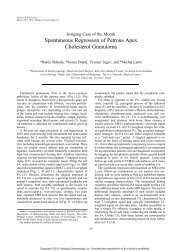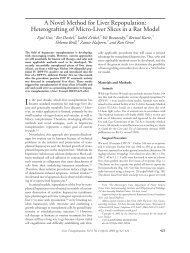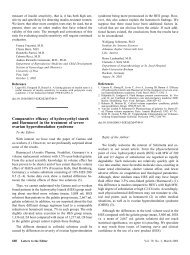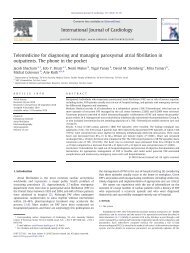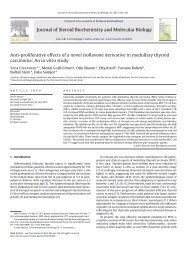Adenoid cystic carcinoma of the salivary giands - Tel-Aviv Sourasky ...
Adenoid cystic carcinoma of the salivary giands - Tel-Aviv Sourasky ...
Adenoid cystic carcinoma of the salivary giands - Tel-Aviv Sourasky ...
Create successful ePaper yourself
Turn your PDF publications into a flip-book with our unique Google optimized e-Paper software.
ORIGINAL ARTICLE<br />
<strong>Adenoid</strong> <strong>cystic</strong> <strong>carcinoma</strong> <strong>of</strong> <strong>the</strong><br />
<strong>salivary</strong> <strong>giands</strong>: A 20-year review<br />
with iong-term foiiow-up<br />
Avi Khafif. MD; Yakir Anavi. DMD; Jacob Haviv, MD, MPH; Rafael Fienmesser, MD;<br />
Shlomo Calderon, DMD; Gideon Marshak, MD<br />
Abstract<br />
The behavior <strong>of</strong> adenoid <strong>cystic</strong> <strong>carcinoma</strong> (ACC) <strong>of</strong> lhe<br />
<strong>salivary</strong> glands has been shown to be ttnpredictable in lenns<br />
<strong>of</strong> local and distant spread and mortality. We retrospectively<br />
studied 35 operations in 34 patients who had had a<br />
pathologic diaf^nosis <strong>of</strong> A CC <strong>of</strong> <strong>the</strong> <strong>salivary</strong> glands and who<br />
had been treated over a 20-year period and followed for a<br />
minimum <strong>of</strong> 10 years. We analyzed <strong>the</strong> effect that different<br />
factors had on otttcomes. The site <strong>of</strong> origin appeared to<br />
be an important factor in survival rates: survivitl among<br />
patients with tumors that had originated in <strong>the</strong> parotid<br />
gland was fairly good, while survival among those with<br />
tumors tlutt originated in <strong>the</strong> minor <strong>salivary</strong> glands was<br />
significantly worse. TNM staging was ano<strong>the</strong>r significant<br />
factor in suirival. O<strong>the</strong>r poor prognostic indicators were<br />
local spread, nodal positivity, distant metastasis, and local<br />
and regional recurrence. Radiation and chemo<strong>the</strong>rapy<br />
did not appear to be beneficial for patients with advanced<br />
disease. We recommend radical surgery with complete<br />
resection for all patients with ACC <strong>of</strong><strong>the</strong> <strong>salivary</strong> glands<br />
and a careful assessment <strong>of</strong> <strong>the</strong> neck in patients with minor<br />
<strong>salivary</strong> gland tumors.<br />
Introduction<br />
<strong>Adenoid</strong> <strong>cystic</strong> <strong>carcinoma</strong> (ACC) is a malignant neoplasm<br />
<strong>of</strong><strong>the</strong> <strong>salivary</strong> glands. It accounts for most cases <strong>of</strong> minor<br />
<strong>salivary</strong> gland malignancie,s and a substantial proportion<br />
<strong>of</strong> parotid and submandibular gland malignancies.' The<br />
behavior <strong>of</strong> ACC has been shown to be unpredictable. The<br />
tumorhas a significantpropensityforperineural spread and<br />
From lhe Department <strong>of</strong> Otolaryngology-Head and Neck Surgery. <strong>Tel</strong><br />
<strong>Aviv</strong> <strong>Sourasky</strong> Medical Center (Dr, Khalif): <strong>the</strong> Department <strong>of</strong><br />
Oral and Maxillolacial Surgery (Dr. Anavi and Dr, Calderon).<br />
<strong>the</strong> Department <strong>of</strong> Otolaryngology-Head and Neck Surgery (Dr,<br />
Fienmesser), and <strong>the</strong> Institute <strong>of</strong> Oncology (Dr, Marshak). Rabin<br />
Medical Center. Beilinson Campus, Petah-Tikva, Israel; and lhe<br />
Israel Defense Forces Medical Corps (Dr, Haviv).<br />
Reprint requests.: Avi Khafif". MD. 66 Hashol'tim Si,, Ramat-Hasharon<br />
47210, Israel. Phone; 972-3-S40-0526; fax; 972-3-.*i40-n526:e-mail;<br />
khatif@tasmc,health.gov.il or avironit@be/eqinl,net<br />
distant metastasis. ACC is associated with a high mortality<br />
rate, and it <strong>of</strong>ten recurs after prolonged periods <strong>of</strong> time. On<br />
<strong>the</strong> o<strong>the</strong>r hand, some patients survive for a considerable<br />
length <strong>of</strong> time even in <strong>the</strong> face <strong>of</strong> distant metastasis.-<br />
Several factors have been considered indicative <strong>of</strong> a poor<br />
prognosis in patients with ACC. including an advanced<br />
tumor stage,'•' a solid histologic type.^^ <strong>the</strong> presence <strong>of</strong><br />
nodal metastasis.'' and <strong>the</strong> presence <strong>of</strong> positive margins and<br />
perineura! spread. Many studies have lacked a satisfactory<br />
follow-up period, a fact that may account for <strong>the</strong> differences<br />
in prognosis among <strong>the</strong>m. In an attempt to clarify some<br />
<strong>of</strong><strong>the</strong> inconsistencies regarding <strong>the</strong> behavior <strong>of</strong> ACC, we<br />
studied a series <strong>of</strong> patients who had been followed for 10<br />
to 30 years.<br />
Patients and methods<br />
From January 1970 through December 1989, 40 patients<br />
with ACC <strong>of</strong><strong>the</strong> <strong>salivary</strong> glands were treated at <strong>the</strong> Beilinson<br />
Campus <strong>of</strong><strong>the</strong> Rabin Medical Center in Petah-Tikva,<br />
Israel. Patients who had been treated within <strong>the</strong> previous<br />
10 years were excluded from <strong>the</strong> study to allow for at least<br />
10 years <strong>of</strong> follow-up.<br />
Sufficient data for inclusion in this study were available<br />
for 34 patients—17 men and 17 women, aged 22 to<br />
80 years (mean: 57.7). The 34 patients underwent a total<br />
<strong>of</strong> 35 operations. Most <strong>of</strong> <strong>the</strong>se patients had superficial<br />
parotid lesions and <strong>the</strong>y had undergone a superhcial parotidectomy;<br />
those who had tumors that involved <strong>the</strong> deep<br />
lobe underwent a total parotidectomy. Preservation <strong>of</strong> <strong>the</strong><br />
facial nerve was attempted in all cases unless <strong>the</strong> nerve was<br />
clearly involved in <strong>the</strong> cancerous process. Submandibular<br />
and minor <strong>salivary</strong> gland tumors were resected with <strong>the</strong><br />
goal <strong>of</strong> achieving adequate margins <strong>of</strong> resection. Lymph<br />
node dissection was performed only on patients who were<br />
lymphadenopathy-positive at presentation. Follow-up<br />
ranged from 10 to 30 years (mean: 15).<br />
We compiled data on factors that might influence survival,<br />
includingTNM stage, local spread(includingperineural and<br />
bone invasion), regional and distant spread, type <strong>of</strong> treat-<br />
662 ENT-Ear, Nose & Throat Journal • October 2005
Table 1. Site <strong>of</strong> origin <strong>of</strong> ACC <strong>of</strong> <strong>the</strong> head and neck in<br />
<strong>the</strong> 34 patients<br />
Site<br />
Parotid gland<br />
Hard palate<br />
Maxillary sinus<br />
Base <strong>of</strong> tbe tongue<br />
Floor <strong>of</strong> <strong>the</strong> mouth<br />
Buccal mucosa<br />
Submandibular gland<br />
Oral tongue<br />
Lower lip<br />
Ethmoid sinus<br />
KHAFIF, ANAVI, HAVIV, FIENMESSER. CALDERON, MARSHAK<br />
n (%)<br />
12 (35.3)<br />
6(17.6)<br />
3 (8.8)<br />
3 (8.8)<br />
3 (8.8)<br />
2 (5.9)<br />
2(5.9)<br />
1 (2.9)<br />
1 (2.9)<br />
1 (2.9)<br />
ment, local and regional recurrence, and distant metastasis.<br />
The impact <strong>of</strong>" <strong>the</strong>se factors on outcome was evaluated by<br />
multiple logistic regression, and <strong>the</strong> different categories<br />
were compared by a chi-square test performed with Sigma-<br />
Stat Statistical S<strong>of</strong>tware (SPSS: Chicago). Linear variables<br />
were analyzed by linear correlation. Kaplan-Meier curves<br />
were generated for disease-free survival.<br />
Results<br />
The most common sites <strong>of</strong> tumor origin were <strong>the</strong> parotid<br />
gland I35.y/r) and <strong>the</strong> minor <strong>salivary</strong> glands <strong>of</strong><strong>the</strong> hard<br />
palate (17.6%) (table 1). Prior to surgery, <strong>the</strong> mo.st common<br />
complaint at presentation {b5.7^/c) and <strong>the</strong> most common<br />
sign on physical examination (77.1%) was a lump in <strong>the</strong><br />
involved gland. O<strong>the</strong>r clinical complaints and physical<br />
signs were seen much less <strong>of</strong>ten; <strong>the</strong> most common <strong>of</strong><br />
<strong>the</strong>se were local pain and oral ulcer (8.69f each).<br />
Of<strong>the</strong> 34 patients, 22 (64.7%) presented with early cancers<br />
(Tl orT2). and <strong>the</strong> remaining 12 (35.3%) had local<br />
or regional advanced disease (T3 or T4) (table 2).<br />
Only 4 patients (11.8%) had regional lymph node metastasis<br />
at <strong>the</strong> time <strong>of</strong> surgery (table 3). and <strong>the</strong>ir treatment<br />
included neckdissection.Threepatients (8.8%) had distant<br />
metastasis. In light <strong>of</strong><strong>the</strong> small numbers <strong>of</strong> patients with<br />
regional and distant metastases al presentation, <strong>the</strong> effect<br />
<strong>of</strong> metastasis on survival could not be evaluated.<br />
Histology. Histologic subtyping was available for 21<br />
patients, 4 <strong>of</strong> whom had predominantly solid tumors. This<br />
small number precluded us from making any histologic<br />
correlations with any <strong>of</strong><strong>the</strong> study parameters.<br />
Treatment. All patients underwent surgical resection<br />
<strong>of</strong> <strong>the</strong>ir primary tumor, with <strong>the</strong> exception <strong>of</strong> 1 patient<br />
who had a distant metastasis at presentation; this patient<br />
was treated with combined radio- and chemo<strong>the</strong>rapy. Two<br />
patients underwent 2 operations each. Nineteen patients<br />
(55.9%) received adjuvant radio<strong>the</strong>rapy in addition to<br />
surgical excision; 6 <strong>of</strong> <strong>the</strong> 19 also received concomitant<br />
chemo<strong>the</strong>rapy.<br />
Table 2. Relationship <strong>of</strong> tumor stage to survival in<br />
<strong>the</strong> 34 patients<br />
Stage Patients Disease-free survival<br />
n n (%)<br />
Tl 10 6(60.0)<br />
T2 12 6 (50.0)<br />
T3 3 1 (33.3)<br />
T4 9 1(11.1)<br />
p - 0.0.^ (ihi-sqimre imalysi\ for linear uswcicilioti).<br />
Recurrence and metastasis. Regional recurrence occurred<br />
in 12 <strong>of</strong> <strong>the</strong> 34 patients (35.3%); 8 <strong>of</strong> <strong>the</strong>se recurrences<br />
developed during follow-up. Distant metastasis<br />
developed in 15 patients (44.1%); 3 tnetastases were<br />
detected at presentation, and 12 developed during followup.<br />
All but 1 <strong>of</strong> <strong>the</strong> patients with regional recurrence and<br />
all patients with distant metastasis died <strong>of</strong> disease within<br />
3 years <strong>of</strong> diagnosis (survival: 8.3 and 0%, respectively).<br />
All patients who presented with regional metastasis died <strong>of</strong><br />
disease during follow-up. The mean length <strong>of</strong> time to <strong>the</strong><br />
development <strong>of</strong> regional recurrence (lO.Oyr) was simitar<br />
to <strong>the</strong> mean length <strong>of</strong> time to <strong>the</strong> development ol' distant<br />
metastasis (9.7 yr); in both cases, <strong>the</strong> range was 1 to 30<br />
years. Only 9 <strong>of</strong><strong>the</strong> 20 patients (45.0%) who developed a<br />
regional recurrence or distant metastasis during follow-up<br />
did so during <strong>the</strong> first 10 years <strong>of</strong> follow-up; <strong>the</strong> remaining<br />
11 patienls(55.0%)developed<strong>the</strong>irrecurrenceormetastasis<br />
between 10 and 20 years <strong>of</strong> follow-up.<br />
Survival. Duringfollow-up, 19<strong>of</strong><strong>the</strong>34patients(55.9%)<br />
died <strong>of</strong> <strong>the</strong>ir disease and 1 patient {2.97c) remained alive<br />
with disease. Of<strong>the</strong> remaining 14 patients. 10 (29.4%)<br />
were alive with no evidence <strong>of</strong> disease and 4 (11.8%) had<br />
died <strong>of</strong> o<strong>the</strong>r causes with no evidence <strong>of</strong> disease; <strong>of</strong> <strong>the</strong><br />
latter 4 patients, 2 died 8 years following treatment and<br />
2 died 2 years after treatment. Disease-free survival was<br />
similar to overall survival—41.2 and 32.3%, respectively<br />
(table 4).<br />
Risk factors. Analysis <strong>of</strong> different risk factors revealed<br />
that <strong>the</strong> site and size <strong>of</strong><strong>the</strong> tumor had a significant effect<br />
on survival, as did surgical margins:<br />
Tumor site. Patients whose tumors originated in <strong>the</strong> parotid<br />
gland (n = 12) had a significantly better survival than<br />
those whose primary tumors arose in <strong>the</strong> minor <strong>salivary</strong><br />
glands (n = 15) (table 5). The tumors in <strong>the</strong> remaining 7<br />
patients had originated in <strong>the</strong> maxillary sinus, base <strong>of</strong><strong>the</strong><br />
tongue, or ethmoid sinus.<br />
Ttwtor .stage. Patients with larger tumors had a higher<br />
mortality rate (p = 0.03) (table 2). Of 9 patients who<br />
presented with T4 lesions. 8 (88.9%) died <strong>of</strong><strong>the</strong> disease<br />
despite surgery and radio<strong>the</strong>rapy. Large tumors had a<br />
greatertendency to spread locally. Local spread (including<br />
pcrineural and bone invasion) was found in II patients.<br />
664 ENT-Ear, Nose & Throat Journal - October 2005
ADENOID CYSTIC CARCINOMA OF THE SALIVARY GLANDS:<br />
A 20-YEAR REVIEW WITH LONGTERM FOLLOW-UP<br />
Table 3. TNM staging <strong>of</strong> ACC <strong>of</strong> <strong>the</strong> head and neck<br />
prior to 35 operations<br />
NO<br />
N1<br />
N2<br />
MO<br />
M1<br />
Tx*<br />
1<br />
0<br />
0<br />
0<br />
1<br />
Tl<br />
9<br />
0<br />
1<br />
10<br />
0<br />
* Unknown primary litniot:<br />
T2<br />
12<br />
0<br />
0<br />
11<br />
and it had a detrimental effect on survival regardless <strong>of</strong><br />
tumor stage. All 3 patients with parotid tumors who had<br />
died <strong>of</strong> <strong>the</strong>ir disease had local spread.<br />
5(/r^/a)/mflrgm.v. At leastone positive margin remained<br />
in 10 patients postoperative I y, and 7 <strong>of</strong> <strong>the</strong>se patients died<br />
<strong>of</strong> disease. Of<strong>the</strong> 24 patients who had negative margins.<br />
<strong>the</strong>re were only 11 deaths (45.8%).<br />
Discussion<br />
In a study <strong>of</strong> a large series <strong>of</strong> patients with ACC. Fordlce<br />
et al reported that nei<strong>the</strong>r tumor site nor tumor stage had<br />
a significant effect on survival.^ However, considering<br />
<strong>the</strong> limited length <strong>of</strong> follow-up in that study (as little as 2<br />
yr in some cases) and <strong>the</strong> tendency <strong>of</strong> ACC to recur late,<br />
<strong>the</strong>ir conclusions should not be considered definitive. The<br />
TNM stage <strong>of</strong> ACC at presentation appears to be relevant<br />
to survival. We demonstrated a linear increase in survival<br />
with decreasing tumor stage. We could not show a correlation<br />
between nodal staging and distant metastasis because<br />
<strong>of</strong><strong>the</strong> small number <strong>of</strong> patients, but we did find a 100%<br />
mortality in cases <strong>of</strong> lymphadenopathy at presentation.<br />
Fordice et al claimed that it was nodal positivity ra<strong>the</strong>r<br />
than nodal stage that is <strong>the</strong> important factor, and we tend<br />
to agree.**<br />
1<br />
Local spread developed in 12 <strong>of</strong> our patients—3 <strong>of</strong><br />
<strong>the</strong> 12 {25.(y7v} who had a parotid tumor and 9 <strong>of</strong> tbe 22<br />
(40.9%) who had aminor<strong>salivary</strong> gland tumor.Thegreater<br />
propensity <strong>of</strong> minor <strong>salivary</strong> gland tumors to spread in<br />
fascial planes and nerves makes complete surgical excision<br />
much more difficult. The main determinant <strong>of</strong> survival is<br />
probably not <strong>the</strong> tumor site per se but <strong>the</strong> propensity for<br />
local spread, whicb is highly influenced by <strong>the</strong> site and<br />
which may result in apositive surgical margin. This iseven<br />
more apparent in ca.ses <strong>of</strong> maxillary sinus <strong>carcinoma</strong>; in<br />
our study. 100% <strong>of</strong> <strong>the</strong>se tumors spread locally, and all<br />
aftected patients died <strong>of</strong> <strong>the</strong> disease. Spiro et al have also<br />
suggested that local spread is a major factor in decreasing<br />
<strong>the</strong> cure rate <strong>of</strong> patients with ACC.' Aggressive primary<br />
resection might be <strong>the</strong> only way to lower <strong>the</strong> mortality<br />
<strong>of</strong> patients with ACC in sites <strong>of</strong> prevalent local spread.<br />
Radiation may improve <strong>the</strong> prognosis in patients with<br />
advanced disease. We did not find this to be meaningful in<br />
Volume 84, Number 10<br />
T3<br />
1<br />
1<br />
1<br />
2<br />
1<br />
T3<br />
8<br />
1<br />
0<br />
9<br />
0<br />
PRESCOTT'S, INC<br />
Introduces..,<br />
OMNI-10<br />
Operating Microscope<br />
Zeiss Opiics<br />
Cost Effective<br />
Great Office Scope<br />
Fiberoptic Illumination<br />
100% Zeiss Compatible<br />
Floor, Ceiling or Wall Mount<br />
Complete Unit Priced<br />
from ie.SOO<br />
OMNI-IO slioiBii on OSM99 Office Stand<br />
PRESCOTT'S, INC.<br />
RO Box609 • Monument, CO 80132<br />
(800)438-3937'(719) 481-3353-Fax (719) 488-2268<br />
ptescott@surgicalmjcto3copes.com • www sutgicaltnictoscopes.cctn<br />
Circle 114 on Reader Service Card<br />
A Quick and Accurate<br />
Test <strong>of</strong> CN I Function<br />
The Smell Identification Test'""(SIT)<br />
• Detect early signs <strong>of</strong> rhinosinusitis<br />
• Chart progression <strong>of</strong> treatment efficacy over time<br />
• Classify degree <strong>of</strong> dysfunction<br />
• Determine percentilo ranks for age and gender<br />
tt Can be self-administered<br />
Developed from NIH lunding, <strong>the</strong> Smell Identification Tesf* (SIT), also known as <strong>the</strong><br />
Utiivetsity ot Pentisyivania Smell Identification Test, is <strong>the</strong> standard tneans tot<br />
quantitativeiy assessing smell function. This test has been administered to nearly a half-<br />
million patients wotid wide, and is featured in hundreds <strong>of</strong> medical publications (see<br />
publicafions list at website below). Now available in English. Ftench, German, and<br />
Spanish versions. Morms based on •- 4,000 subjects.<br />
Visit us at wvwv.smelttest.com<br />
i SiNSONlCS, INC • (800) 547-8838<br />
P.O. Box 112, Haddon Heights, NJ 08035-0012 USA<br />
Circle 115 on Reader Service Card<br />
665
I found more*<br />
"CompHealth found <strong>the</strong> perfect match for me.<br />
1 like thiit kind <strong>of</strong> one-on-one attention—ihey<br />
diii an excellent job."<br />
Ailm D. Wiliimm. M.D,<br />
PENNSYLVANIA —PROGRESSIVE HOSPITAL<br />
EXPERIENCING PHENOMENAL GROWTH seeks<br />
general ENT. Client is building new state-<strong>of</strong>-<strong>the</strong>-art<br />
center for ENT specifically. Be busy immediately with<br />
large referral base <strong>of</strong> 40 physicians. Salary is approximately<br />
5300K, plus production bonus that equates<br />
to 70% <strong>of</strong> net income. Phenomenal benefits, including<br />
relocation. Family-oriented community located<br />
in picturesque Amish country. Easy access to<br />
Pittsburgh, Cleveland and numerous attractions.<br />
For more information on this prestigious position,<br />
contact Bruce Guyant today!<br />
800-328-3666, ext. 7911<br />
bgu yan t@co mphealth -com.<br />
Ref. #913011<br />
2005 CompHealth<br />
lEPRI,<br />
666<br />
Circle 116 on Reader Service Card<br />
Reprints <strong>of</strong> articles published in ENT<br />
JOURNAL are available (in quantities<br />
<strong>of</strong> 100 or more) by contacting;<br />
Al Palmisano<br />
Bergano Reprint Marketing<br />
866-377-6454<br />
KHAFIF, ANAVI, HAVIV, FIENMESSER, CALDERON, MARSHAK<br />
Table 4. Survival and mortality according<br />
status among <strong>the</strong> 34 patients<br />
With ACC<br />
Without ACC<br />
Total<br />
Alive<br />
n(%)<br />
1 {2.9}<br />
10(29.4)<br />
11 (32.3)<br />
Died<br />
n (%)<br />
19 (55.9)<br />
4(11.8)<br />
23 (67.7)<br />
to disease<br />
Total<br />
n(%)<br />
20 (58.8)<br />
14 (41.2)<br />
34(100)<br />
our patients, but we cannot draw any conclusions because<br />
<strong>of</strong><strong>the</strong> selection bias—that is. patients with more advanced<br />
disease were also treated with radio<strong>the</strong>rapy. In ano<strong>the</strong>r<br />
study. Spiro et al' reported that postoperative radio<strong>the</strong>rapy<br />
conferred no advantage, but o<strong>the</strong>rs^'' have shown that ACC<br />
is radiosensitive, although not necessarily radiocurable."<br />
Radiation, <strong>the</strong>refore, might still be <strong>of</strong> value both in treating<br />
(postoperutively) locally advanced disease and in treating<br />
patients who refuse surgical resection.<br />
As expected, both regional recurrence and distant metastasis<br />
were predictors <strong>of</strong> poor survival, and aggressive<br />
treatment <strong>of</strong> recurrences did not have an effect on outcome.<br />
Treatment delivered to <strong>the</strong> neck should be tailored to <strong>the</strong><br />
specific site <strong>of</strong> origin, as has been proposed by Garden et<br />
al.'" In our series, <strong>the</strong>re was not even I case <strong>of</strong> regional<br />
recun-ence among <strong>the</strong> 12 patients with parotid ACC. as<br />
opposed to 11 regional recurrences in <strong>the</strong> remaining 22<br />
patients (50.0%). We suggest careful evaluation and foilowupexaminations<br />
<strong>of</strong><strong>the</strong> neck, including ultrasonography. in<br />
cases <strong>of</strong> ACC that originate in <strong>the</strong> minor <strong>salivary</strong> glands.<br />
Surgery shouldentall lymph node dissection, which can be<br />
limited to <strong>the</strong> area <strong>of</strong> maximal drainage; one such option<br />
is supraomohyoid neck dissection for oral cavity tumors.<br />
Again, we emphasize <strong>the</strong> poor prognosis <strong>of</strong> our patients<br />
with regional recurrences (survival: 8.3'7^). indicating <strong>the</strong><br />
importance <strong>of</strong> prevention <strong>of</strong> regional recurrence.<br />
In <strong>the</strong> specific case <strong>of</strong> ACC <strong>of</strong> <strong>the</strong> submandibular gland,<br />
we recommend surgical excision <strong>of</strong> <strong>the</strong> submandibular<br />
triangle as <strong>the</strong> biopsy procedure. We cannot recommend<br />
elective treatment to <strong>the</strong> neck for <strong>the</strong>se patients because <strong>of</strong><br />
<strong>the</strong> small number <strong>of</strong> patients in our study who had primary<br />
disease at that site. Obviously, more studies are needed<br />
to determine <strong>the</strong> patterns <strong>of</strong> regional spread in ACC, as<br />
well as <strong>the</strong> preferred treatment modality and <strong>the</strong> role <strong>of</strong><br />
preventive neck dissections.<br />
Of <strong>the</strong> 6 patients in our series who received chemo<strong>the</strong>rapy.<br />
I had early-stage disease and survived, and <strong>the</strong><br />
o<strong>the</strong>r 5 had advanced disease and died <strong>of</strong> <strong>the</strong>ir disease<br />
despite aggressive treatment. Thus, in contrast to findings<br />
reported by Spiroet al,^ we observed no advantage to adding<br />
chemo<strong>the</strong>rapy to tfie treatment protocol for patients with<br />
advanced ACC. Asimilar observation was reported by Hill<br />
et al. who found that <strong>the</strong> combination <strong>of</strong> cispiatinum and<br />
5-fluorouracil resulted in no major improvement in survival<br />
ENT-Ear, Nose & Throat Journal • October 2005
ADENOID CYSTIC CARCINOMA OF THE SALIVARY GLANDS:<br />
A 20 YEAR REVIEW WITH LONG-TERM FOLLOW-UP<br />
Table 5. Outcome <strong>of</strong> <strong>the</strong> 27 patients with<br />
minor <strong>salivary</strong> gland tumors<br />
Disease-free survival*<br />
n(


